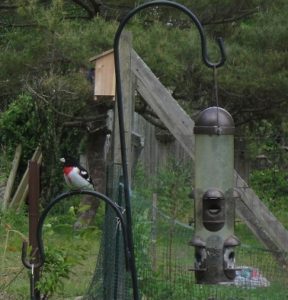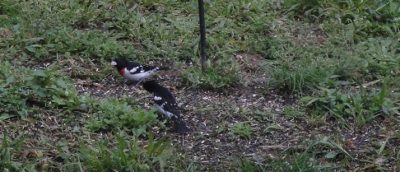The Rose-Breasted Grosbeak

A rose-breasted grosbeak at the feeder.
Something special is happening in the yard, and you reach for the camera only to find there’s no remaining memory. So, you quickly delete a few old photos, rush back to the window…and sadly discover the moment has passed.
Has that ever happened to you? I use a digital camera because I’m old-school, you might say, and haven’t yet activated the cell phone. Mea culpa.
But I learned my lesson the last time I tried to catch a fleeting moment. So, I regularly go through the camera’s photos and delete most that already have been stored on the computer. When one of those special moments happens, I’m prepared! (Oh, you thought I was going to say that I had finally activated the cell phone? Some day.)
Two days after a low-ranking tornado and hailstorm blew through Elkin on 4/28/2023, a couple of strange birds showed up at the feeders. They looked like a cross between a cardinal and a towhee. Bold beak, about the same size (8″ long), black with sharply contrasting white patches on the wings, and a bright red bib. Never saw them before.

70+ mph winds gusting to ?? blew this canopy with 200 lbs. of cinderblocks, some still attached, 40′ from its original location.
A Delightful Visit
The triangular red patch is diagnostic for a mature male of this species. It’s the rose-breasted grosbeak (French gros = large), or Pheucticus ludovicianus. No surprise, rose-breasted grosbeaks are related to cardinals in the family Cardinalidae, and also to buntings.
The female is less colorful, resembling a female purple finch but 2″ larger. Her eyebrow stripe (supercilium) is white, her plumage is predominantly rich brown with white bars, and she has a spotted buff-colored chest. Male grosbeaks have a white bill, while the female’s is dull pink.
Two colorful males visited the feeders, apparently unaccompanied by females. Their song resembles that of a robin and the callnote is a sharp pink.
Aiming through the kitchen window, I took a few pictures of these beautiful birds. They hopped from one feeder to the other and to the ground, and sometimes flew into the high branches of a tall oak tree near the edge of the woods. After 15 minutes, they left.
I wonder if the high winds from the storm might have pushed them off course. Regardless, their presence in my garden provided one of the most delightful surprises this bird watcher has ever seen.
Where Rose-Breasted Grosbeaks Live
Their paths of migration in spring and autumn take them through the southeast quadrant of the U.S. Migration routes extend west from Montana to central Texas. After overwintering in Mexico, the Caribbean islands, and northwestern South America, they fly north through this part of North Carolina around early May.
These grosbeaks settle in their summer breeding grounds around deciduous forest edges and suburbs. Their summer range includes the Mid-Atlantic region and New England, west to the Dakotas and as far south as southern Missouri. They also travel farther north to the area around the Great Lakes, along the U.S./Canada border, and into central Canada.
According to the maps, rose-breasted grosbeaks might breed as far as Wilkes County in NC, where I live. The birds are more commonly spotted during the breeding season, however, farther north and in the higher elevations of a narrow strip of habitation extending through the Appalachian Mountains as far south as northern Georgia.
These birds often visit feeding stations as they migrate and throughout the year. Sunflower and safflower seeds, raw peanuts, and clean water might attract them to your garden. They also eat insects, so not spraying pesticides—but letting nature “happen”—might give you that photo op you’ve been hoping for.
Feeding and Breeding Habits of the Rose-Breasted Grosbeak
Rose-breasted grosbeaks feed on a wide assortment of insects and plant parts. In one study of dead birds, their stomach contents comprised 52% invertebrates (mostly beetles, also caterpillars, grubs, sawflies, bees, moths, ants, snails, and spiders), 20% wild fruits, 16% weed seeds, 6% cultivated plants, and 6% tree buds and flowers. They can catch insects in flight and occasionally sample nectar. For their young, these grosbeaks provide mostly protein-rich insects.
Both male and female rose-breasted grosbeaks select the nest site, usually located in an elevated position in tree crotches or tall shrubs. They prefer nesting and feeding near openings in a woodland.
The nest is a rather flimsy collection of twigs, leaves, roots, and animal hair. These birds lay between 1 and 5 eggs, with 3-4 being the average. Eggs are pale bluish green with reddish brown spots. Although the female does most of the nest-building and incubation, the male does participate and also helps feed the chicks. Chicks hatch after 11-14 days, fledge after 9-13 days, and gain their independence at 3 weeks of age. They have 1, sometimes 2, broods in a season.
Rose-breasted grosbeaks live an average of about 7 years in the wild. In captivity, they’ve been documented to live as long as 24 years.
They don’t winter in the piedmont of North Carolina but will again pass through the area in autumn on their way to southern lowlands and foothills. I hope to catch them on their return route to their winter grounds—with better camera shots, of course.

Two male rose-breasted grosbeaks searching for sunflower seeds.